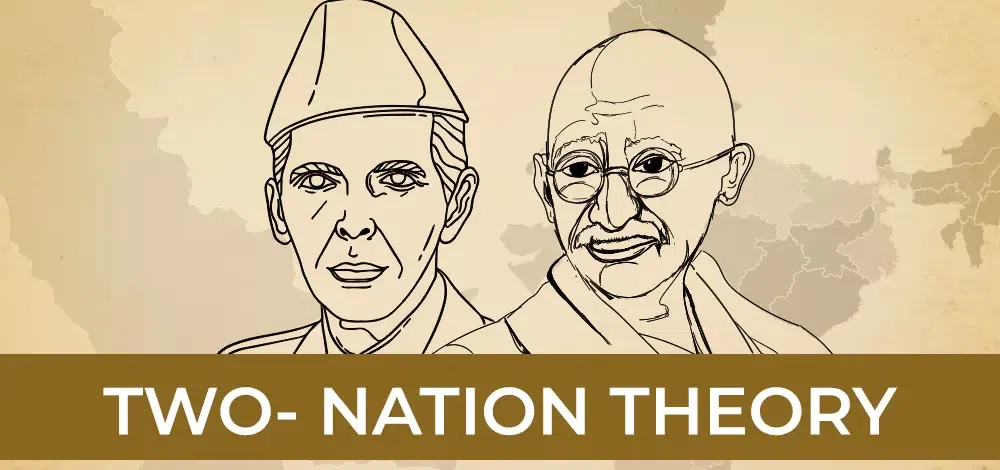Who gave the ‘two-nation’ theory?
Last Updated :
11 May, 2023
Sir Syed Ahmad Khan was viewed as the primary draftsman of the Two-Nation hypothesis as he gave a cutting-edge figure of speech wherein to communicate the journey of Islamic personality. The two-country hypothesis is a philosophy of strict patriotism that essentially affected the Indian subcontinent following its autonomy from the British Empire.

Two Nation Theory
Two-Nation Theory
The two-Nation Theory is a political principle defending the division of India politically into two free countries’ India and Pakistan. The idea was propounded by Muhammad Ali Jinnah during the 1940s just before the ending up of the British rule in India. The precept has an electing foundation. The different electorate framework was presented in stages for the Muslims and Hindus under the protected changes of 1909, 1919, and 1935. Under the different electorate framework, Muslims could choose their own possibility to address them in the commonplace administrative boards and regulative gatherings, and political powers in the Muslim larger part areas of India.
Muslim Ministries were shaped in Bengal and in the North Western Provinces. Being introduced into power through the different electorate framework, a few Muslim pioneers presently started to think about transforming the valuable separate electorate framework into a different patriot thought called the two-country hypothesis stating that the Muslims of India shaped a different country out and out by and large, socially, mentally, and socially. This thought was first expressed by Sir Syed Ahmad Khan (1817-1898) who initially began the development of Muslim self-arousing and personality. Sir Syed Ahmad discouraged the Indian Muslim people group to join the temporary fad of the Congress patriot development. He explained that the Indian Muslims themselves framed a country and to their greatest advantage shouldn’t align themselves with the Congress-drove developments for self-rule. His thought found great gathering from the pioneer rulers, who required partners to deal with the developing Indian patriot development sent off by the Congress.
The congress’s non-co-activity of the Diarchy constitution at the common level had estranged extensive Muslim political components from the patriot legislative issues of the Congress and subsequently, the Muslim League, which was doomed until 1929, turned out to be progressively the vehicle of Muslim governmental issues in Bengal and furthermore in other Muslim larger part regions. Writer and scholar Sir Muhammad Iqbal’s official location at the Muslim League’s gathering in December 1930 laid the hypothetical system of the two-country hypothesis. He further expounded his perspective of Muslim nationhood in a reply to an assertion made by Pandit Jawahar Lal Nehru at the London Round Table Conference expressing that the demeanor of the Muslim designation depended on ‘reactionism’. Iqbal finished up his response:
‘All in all, I should put a straight inquiry to savant Jawahar Lal, how is India’s concern to be settled in the event that the greater part local area will neither yield the base shields essential for the security of a minority of 80 million individuals nor acknowledge the honor of an outsider (Communal Award of British Prime Minister McDonald); yet keep on discussing a sort of patriotism which works out just to its own benefitFoodgrain This position can concede to just two other options. Either the Indian larger part local area should acknowledge for itself the stable situation of a specialist of the British government in the East, or the nation should be rearranged on a premise of strict, verifiable, and social affinities to get rid of the subject of (isolated) electorates and the collective issue in its current structure. Muhammad Ali Jinnah, leader of the Muslim League presently in power in a few regions of India including Bengal, made sense of his Two Nation Theory in its last structure in his official location at Lahore on March 22’23, 1940.
Related Links
- Impact of Partition on the Indian Economy
- Partition of Bengal
- All India Muslim League Notes with MCQs
FAQs on Who Gave Two-Nation Theory
Q 1. What is a two-country theory?
Answer-
“Two-Nation Theory” alludes to the postulation that Hindus and Muslims in India were two unmistakable networks that couldn’t coincide inside a solitary state without overwhelming and oppressing the other or without a steady clash; it brought about the 1947 Partition of India and Pakistan.
Q 2. When was the two-country theory introduced?
Answer-
In 1940 in Lahore Muhammad Ali Jinnah, the one who established Pakistan, gave an original discourse setting out the requirement for a different state for Muslims on the subcontinent. Preceding the division of India in 1947, Hindus and Muslims had lived respectively the nation over. However, Jinnah portrayed them as two separate countries.
Q 3. Who opposed the two-nation theory?
Answer-
The two-nation theory was opposed by Mufti Mahmud, who was associated with Darul Uloom Deoband, who came to oppose the partition of India.
Like Article
Suggest improvement
Share your thoughts in the comments
Please Login to comment...